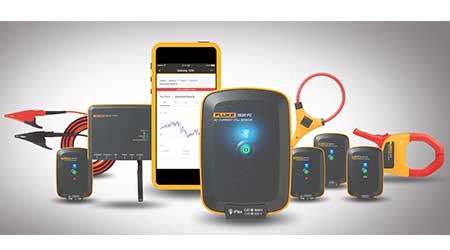« Facilities Technology Briefs Home /
Equipment Rental & Tools
Sensor Monitoring System Powered by Internet of Things Concept - Fluke Corp. - Facility Management Product Release

Fluke Corp.
website
| Company information
Doing more with less is the norm for maintenance and engineering managers. Whether it is time, skilled labor, or budget, there are never enough resources to go around. Yet the demand for uptime has never been greater as institutional and commercial more fully realize the cost of equipment failures.
The big issue: intermittent faults, which:
● Are caused by a combination of factors that often require taking measurements with handheld tools across multiple assets.
● Lead to at least one hour of technician productivity waste every day.
● Can create a constant rush-to-the-next-failure approach to maintenance that never allows teams to get ahead nor allow managers to deploy their teams in the most effective way.
● Occur across every class of assets.
Tier 1: most critical assets have built-in sensors that provide early indications of problems that need to be addressed.
Tier 2: 4 million other assets like pumps, heat exchangers, compressors, and blowers have not warranted sensors due to cost or the impractically but can shut down a plant just as effectively.
Older assets: many plants have equipment that may be decades old — hardly the era of smart devices — so plugging them into the internet is either very difficult or impossible.
Fluke Condition Monitoring was designed to help maintenance teams monitor a large array of equipment of any age continuously and automatically to better understand the health of critical assets in a plant — when it’s needed, where it’s needed.
Fluke Condition Monitoring is a new, always-on, Industrial Internet of Things condition monitoring system consisting of:
● Wireless sensors measuring AC and DC voltage and current, temperature, and three-phase power monitoring. The sensors send measurements 24 hours a day for up to 40 days and as frequently as once a second in order to catch intermittent problems when they occur.
● A gateway that receives signals from the sensors up to 30 feet away and streams measurement data to the cloud, feeding Fluke Connect software.
● Fluke Connect Condition Monitoring software and mobile app, which compares streaming measurements against thresholds to trigger alarms when exceeded and compiles measurements from sensors and Fluke wireless tools to create a comprehensive view of equipment health.
Fluke Condition Monitoring features familiar Fluke technologies, such as iFlex, current clamps, and probes so there is virtually no learning curve. The sensors, gateway and alarms can be installed in less than an hour by staff technicians, and the power quality monitor features the same industry-leading ease-of-use as other Fluke power loggers.
The system is highly portable and takes just minutes to move from one piece of equipment to another to monitor asset health where it is most needed. All the hardware is drop-tested and the sensors are IP 54 and CAT rated to withstand the harsh conditions found in most plants.
Who uses Fluke Condition Monitoring?
In-house maintenance managers — they have too many faults occurring all across the plant and
not enough trained technicians to cover all the issues. Fluke Condition Monitoring provides: Flexibility to continuously monitor the particular equipment that needs it on a given day or week; more efficient use of manpower; when a fault occurs, attach multiple sensors and leave them monitoring instead of spending all day troubleshooting; technology that is familiar and that technicians can install without outside resources.; and remote power monitoring with a continuous data stream, essential for troubleshooting system conflicts
Fluke Condition Monitoring provides a scalable system to address the major challenges maintenance managers face.
1. Problems go unnoticed until they’re catastrophic. Un-monitored equipment often stays under the radar. Because the Fluke Condition Monitoring system can be easily moved around the plant, it delivers the versatility to monitor whatever system aspect is necessary to solve a problem. Measurements can be logged 24/7 and set up with text and/or email alerts so that technicians and managers can leave the plant with the peace of mind that the problem is being watched.
Persistent power quality problems that go unresolved. Some power quality conflicts can’t be solved without remote monitoring, and previous options have been either prohibitively expensive and difficult to install or don’t provide enough information to pinpoint the issue. The live data stream from the Fluke 3540 FC Three-Phase Power Monitor to the Fluke Connect app and software shows technicians and engineers the trends and fluctuations they need to diagnose the problem.
Limited analysis capabilities. The inability to track equipment over time results in piecemeal, inconsistent information, making it difficult to analyze machine health. Machines without monitoring can become the weakest link in the production chain, threatening downtime. Fluke Condition Monitoring automatically logs data and aligns historical readings against current conditions, making it easier to detect faults and prevent unplanned downtime.
Fixed sensors can be expensive and lack flexibility. Fixed sensors necessitate a sizable investment in design, engineering, and IT and can be cost prohibitive to permanently install on every piece of tier 2 equipment. The Fluke Condition Monitoring system provides a flexible, cost-effective, and easy to operate alternative. Whether taking simple electrical and temperature measurements or power monitoring, Fluke provides a portable cohesive system designed to deliver equipment monitoring as needed. Maintenance teams can now anticipate issues instead of chasing after failures.
RELATED CONTENT
Content Category: Equipment Rental & Tools
FEATURES:
QUICK READS:
posted: 7/25/2016








